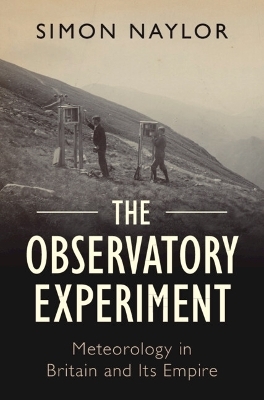
The Observatory Experiment
Meteorology in Britain and Its Empire
Seiten
2024
Cambridge University Press (Verlag)
978-1-009-20723-2 (ISBN)
Cambridge University Press (Verlag)
978-1-009-20723-2 (ISBN)
- Titel z.Zt. nicht lieferbar
- Versandkostenfrei innerhalb Deutschlands
- Auch auf Rechnung
- Verfügbarkeit in der Filiale vor Ort prüfen
- Artikel merken
In this innovative history of the science of meteorology, Simon Naylor focuses on the spaces in which it was pursued: meteorological observatories. Using previously understudied archival material, he reconstructs these sites and the research carried out in them, in doing so treating meteorology as an experimental observatory science.
In this innovative history of the science of meteorology, Simon Naylor focuses our attention on the spaces in which it was pursued: meteorological observatories. During the nineteenth century, meteorologists established or converted sites where observers and their instruments could be housed, where they collected and analysed data and developed meteorological theories. He examines a number of these sites around the British Empire, along with the governmental, military and commercial networks connecting them. Taking many shapes to capture the weather in different environments, these observatories brought various social groups into contact with the practice of science, including sailors on naval surveying vessels, climbers ascending Scottish peaks, and families checking their rain gauges at home. Through a study of these spaces, Naylor argues for the treatment of meteorology as an experimental observatory science, on which the development of knowledge about local, regional, national and global weather and climate relied.
In this innovative history of the science of meteorology, Simon Naylor focuses our attention on the spaces in which it was pursued: meteorological observatories. During the nineteenth century, meteorologists established or converted sites where observers and their instruments could be housed, where they collected and analysed data and developed meteorological theories. He examines a number of these sites around the British Empire, along with the governmental, military and commercial networks connecting them. Taking many shapes to capture the weather in different environments, these observatories brought various social groups into contact with the practice of science, including sailors on naval surveying vessels, climbers ascending Scottish peaks, and families checking their rain gauges at home. Through a study of these spaces, Naylor argues for the treatment of meteorology as an experimental observatory science, on which the development of knowledge about local, regional, national and global weather and climate relied.
Simon Naylor is Professor of Historical Geography at the University of Glasgow. He is the author of Regionalizing Science: Placing Knowledges in Victorian England (2010).
Introduction: Observatory experiments; 1. Meteorology all at sea; 2. Meteorology at the colonial observatories; 3. Mountain meteorology on Ben Nevis; 4. Geographies of the rain; Conclusion: Historical geographies of future weather.
| Erscheinungsdatum | 11.10.2024 |
|---|---|
| Reihe/Serie | Science in History |
| Zusatzinfo | Worked examples or Exercises |
| Verlagsort | Cambridge |
| Sprache | englisch |
| Maße | 157 x 235 mm |
| Gewicht | 580 g |
| Themenwelt | Geschichte ► Teilgebiete der Geschichte ► Technikgeschichte |
| Naturwissenschaften ► Geowissenschaften ► Meteorologie / Klimatologie | |
| Naturwissenschaften ► Physik / Astronomie ► Astronomie / Astrophysik | |
| ISBN-10 | 1-009-20723-7 / 1009207237 |
| ISBN-13 | 978-1-009-20723-2 / 9781009207232 |
| Zustand | Neuware |
| Informationen gemäß Produktsicherheitsverordnung (GPSR) | |
| Haben Sie eine Frage zum Produkt? |
Mehr entdecken
aus dem Bereich
aus dem Bereich
Buch | Softcover (2024)
Lehmanns Media (Verlag)
19,95 €
Eine superschnelle Menschheitsgeschichte des digitalen Universums
Buch | Hardcover (2024)
Heyne (Verlag)
24,00 €


